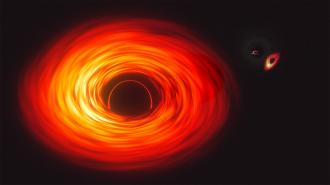New NASA video shows just how big black holes really are
A new NASA animation puts the size of 10 supermassive black holes into perspective — by showing how some of them simply dwarf our entire solar system.
Black holes: Black holes are points in space where gravity is so strong, even light can’t escape its pull. The point of no return around a black hole is called its “event horizon,” and while we can’t see anything inside it, we can learn about black holes from what’s around them.
That’s because matter accelerates and emits energy as it approaches a black hole. This creates a bright ring around the black hole, and because of the way space-time warps big objects, we see a “shadow” inside the ring that’s about twice the diameter of the black hole itself.
Size ‘em up: Researchers estimate that there are 40 billion billion black holes in the universe, but the ones we’ve detected so far range in size from the relatively small (three times the mass of the sun) up to the super supermassive (tens of billions of solar masses).
To help put this into perspective, NASA has created an animation comparing the size of 10 supermassive black holes to our solar system.
The black holes are arranged by the size of their shadows. The smallest featured black hole lies at the center of the galaxy known as 1601+3113 and has the mass of merely 100,000 suns. The black hole at the center of our own galaxy, Sagittarius A*, falls in the middle size-wise, with a mass of 4.3 million suns.
The largest black hole in the animation, TON 618, is equal to 60 billion suns. Its shadow is so large that it would take light itself — the fastest thing in the universe — two weeks to travel from one side of it to the other.
To put that into perspective, light can travel the distance from the sun to Neptune, the farthest planet in our solar system, in just four hours.
We’d love to hear from you! If you have a comment about this article or if you have a tip for a future Freethink story, please email us at tips@freethink.com.
